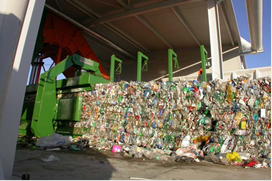Integrated Waste Management

The integrated waste management was introduced in Italy by the Environmental Law of 1997 and then integrated in the second environmental law of 2006.
The Italian law determines the priority criteria, which are in the order:
- the prevention of waste generation
- reuse
- recycling of materials
- the use for energy purposes
- disposal into landfills
In Italy, the sorted collection of waste is increasingly common, which is the basis of an efficient system of recovery and recycling, reaching a percentage of 42.3% compared to the total waste collected.
European legislation has set a 50% target for recycling of recyclable waste by 2020; as a matter of fact, already seven of the 20 Regions of Italy have achieved this goal in 2014, while other regions are very close, leading the European rankings.
The recycling of materials pushes towards the adoption of circular economy models, while obvious benefits are achieved because of the energy savings (2.2 billion euro for energy were saved thanks to the recovery of packaging) and because the reuse in the production cycle of materials (a net profits of 1.2 billion for the recycling of PET).
The achievement of optimal goals requires an integrated approach, which takes into account the entire life cycle of the waste, in the specific context in which it is produced.
Typically, the sorted waste are processed by pre-treatment systems, which improve the separation of plastics, wood, metals, glass and paper, sending them to recycling, while the organic waste is used for the production of quality compost or used for the production of biogas through anaerobic digesters.
The unsorted waste is handled by processes of drying and mechanical-biological systems, which allow to separate the materials, which afterwards, depending on their nature, can be processed into compost, while another part is transformed into Secondary Solid Fuels, that has a heating value higher than that of untreated waste and that can be used in coal-fired power generation plants, allowing, thus, to reduce CO2 emissions.
Innovative technologies allow to use plastics of little value, various scrap and sludge for the production of synthetic-oil, a product usable as lubricant or fuel.
The integrated approach not only reduces drastically the disposal of waste into landfills, but allows to reuse the latter as a deposits of matter to be recovered. The old landfills, in fact, not only can be used to produce biogas, but, following a scrupulous characterization and a stabilization process, can be reopened, with the purpose to sort and recover recyclable materials stored in them.
The Eco-Cluster of Venice represents a significant example of excellence: the system collects the waste produced by a population of about one million inhabitants and over 40 million tourists per year (25 million only in the old town, the rest in the seaside resorts of the coast), managing to maintain a certified standard of recovery, such that only 3% of the waste is disposed into landfills, while the remainder is recycled as a raw material or used for the production of energy.
Some types of waste, such as the tires, were faced with a nationwide systemic approach: thanks to a law of 2011, a small part of the price of new tires is used as an environmental contribution, which is awarded to plants dealing with end of life tires.
All tires are collected and conferred in such plants, which proceed to a processing that separates metal, textile fibers and rubber, which is grinded it into granulates of different size, depending on the end uses; rubber and metals are then sold as a secondary raw material.
Sometimes, the tire rubber is used for the production of energy, with pyrolysis processes, where there are the conditions for the recovery of heat (for example for pre-heating water).